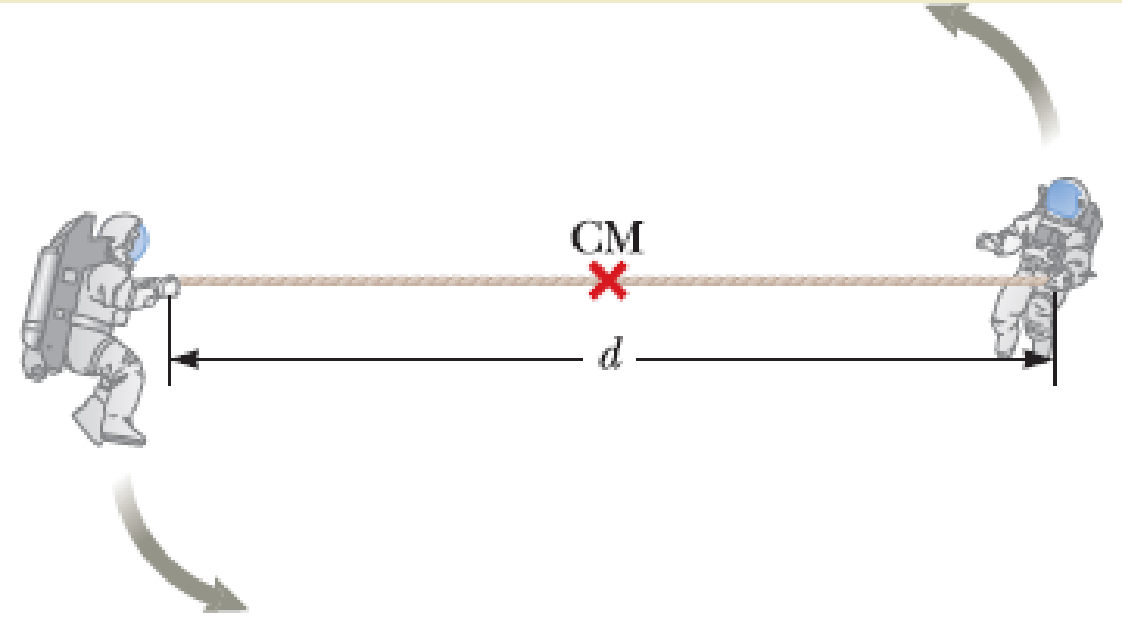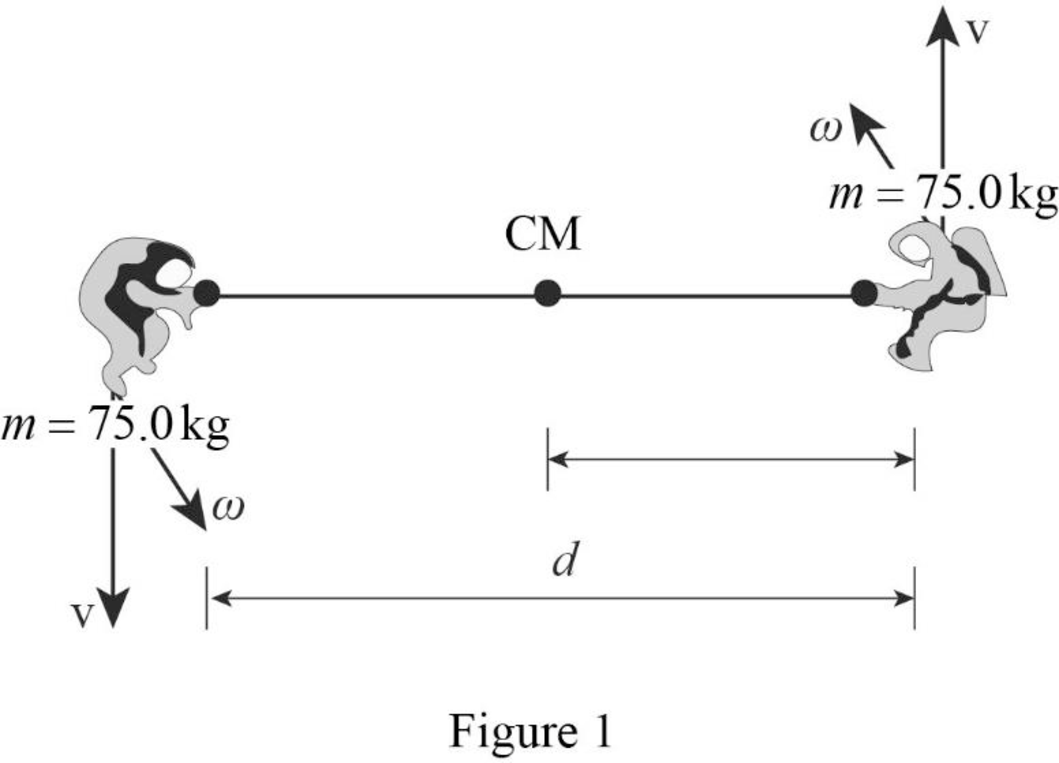
Concept explainers
Two astronauts (Fig. P10.67), each having a mass of 75.0 kg, are connected by a 10.0-m rope of negligible mass. They are isolated in space, orbiting their center of mass at speeds of 5.00 m/s. Treating the astronauts as particles, calculate
- (a) the magnitude of the
angular momentum of the two-astronaut system and - (b) the rotational energy of the system. By pulling on the rope, one astronaut shortens the distance between them to 5.00 m.
- (c) What is the new angular momentum of the system?
- (d) What are the astronauts’ new speeds?
- (e) What is the new rotational energy of the system?
- (f) How much chemical potential energy in the body of the astronaut was converted to mechanical energy in the system when he shortened the rope?

Figure P10.67 Problems 67 and 68.
(a)
The magnitude of angular momentum of the two astronaut system.
Answer to Problem 67P
The magnitude of angular momentum of the two astronaut system is
Explanation of Solution
Consider the figure given below.

Write the expression for the magnitude of angular momentum.
Here,
From figure
Conclusion:
Substitute,
Therefore, the magnitude of angular momentum of the two astronaut system is
(b)
The rotational kinetic energy of the system.
Answer to Problem 67P
The rotational kinetic energy of the system is
Explanation of Solution
The total rotational kinetic energy is the sum of the kinetic energy of two astronauts.
Write the expression for the rotational kinetic energy.
Here,
Conclusion:
The mass, and speed of two astronauts are same.
Substitute,
Therefore, the rotational kinetic energy of the system is
(c)
The angular momentum when one of the astronaut shortens the distance between them to
Answer to Problem 67P
The angular momentum when one of the astronaut shortens the distance between them to
Explanation of Solution
Even if the distance between the astronauts changed, the tension of the rope not generating ant torque about the center of mass. Since there is no change in torque the angular momentum of two astronaut –rope system will be same as that of the initial case
Since there is no outside torque the angular momentum when one of the astronaut shortens the distance between them to
Conclusion:
Therefore, the angular momentum when one of the astronaut shortens the distance between them to
(d)
The speed of the astronauts after shortening the distance.
Answer to Problem 67P
The speed of the astronauts after shortening the distance is
Explanation of Solution
Use equation (III) to find the new speed of the astronauts. The angular momentum of the system remains same even if he distance between the astronauts changes.
Conclusion:
Substitute,
Therefore, the speed of the astronauts after shortening the distance is
(f)
The new rotational kinetic energy of the system.
Answer to Problem 67P
The new rotational kinetic energy of the system is
Explanation of Solution
The total rotational kinetic energy is the sum of the kinetic energy of two astronauts.
Write the expression for the rotational kinetic energy.
Here,
Conclusion:
The mass, and speed of two astronauts are same.
Substitute,
Therefore, the rotational kinetic energy of the system is
(e)
The amount of chemical; energy converted to mechanical energy.
Answer to Problem 67P
The amount of chemical; energy converted to mechanical energy is
Explanation of Solution
The amount of chemical; energy converted to mechanical energy is equal to the work done by the astronaut. According to work energy theorem the work dine will be the change in rotational kinetic energy.
Write the expression for work done.
Conclusion:
Substitute,
Therefore, the amount of chemical; energy converted to mechanical energy is
Want to see more full solutions like this?
Chapter 10 Solutions
Principles of Physics: A Calculus-Based Text, Hybrid (with Enhanced WebAssign Printed Access Card)
- Solve and answer the question correctly please. Thank you!!arrow_forward་ The position of a particle is described by r = (300e 0.5t) mm and 0 = (0.3t²) rad, where t is in seconds. Part A Determine the magnitude of the particle's velocity at the instant t = 1.5 s. Express your answer to three significant figures and include the appropriate units. v = Value Submit Request Answer Part B ? Units Determine the magnitude of the particle's acceleration at the instant t = 1.5 s. Express your answer to three significant figures and include the appropriate units. a = Value A ? Unitsarrow_forwardSolve and answer the question correctly please. Thank you!!arrow_forward
- Solve and answer the question correctly please. Thank you!!arrow_forwardA spiral transition curve is used on railroads to connect a straight portion of the track with a curved portion. (Figure 1) Part A v = v₁ft/s 600 ft y = (106) x³ If the spiral is defined by the equation y = (106)³, where x and y are in feet, determine the magnitude of the acceleration of a train engine moving with a constant speed of v₁ = 30 ft/s when it is at point x = 600 ft. Express your answer to three significant figures and include the appropriate units. ? a = Value Unitsarrow_forwardsolve and answer the problem correctly please. Thank you!!arrow_forward
- Solve and answer the question correctly please. Thank you!!arrow_forwardSolve and answer the question correctly please. Thank you!!arrow_forwardWhen the motorcyclist is at A, he increases his speed along the vertical circular path at the rate of = (0.3t) ft/s², where t is in seconds. Take p = 360 ft. (Figure 1) Part A 60° Ρ B If he starts from rest at A, determine the magnitude of his velocity when he reaches B. Express your answer to three significant figures and include the appropriate units. v = Value Submit Request Answer ་ Part B ? Units If he starts from rest at A, determine the magnitude of his acceleration when he reaches B. Express your answer to three significant figures and include the appropriate units. 11 ? a = Value Unitsarrow_forward
- The car starts from rest at s = 0 and increases its speed at a₁ = 7 m/s². (Figure 1) Part A = 40 m Determine the time when the magnitude of acceleration becomes 20 m/s². Express your answer to three significant figures and include the appropriate units. ? t = Value Units Part B At what position s does this occur? Express your answer to three significant figures and include the appropriate units. s = Value Submit Request Answer ? Unitsarrow_forwardSolve and answer the question correctly please. Thank you!!arrow_forwardSolve and answer the question correctly please. Thank you!!arrow_forward
 Principles of Physics: A Calculus-Based TextPhysicsISBN:9781133104261Author:Raymond A. Serway, John W. JewettPublisher:Cengage Learning
Principles of Physics: A Calculus-Based TextPhysicsISBN:9781133104261Author:Raymond A. Serway, John W. JewettPublisher:Cengage Learning Physics for Scientists and Engineers: Foundations...PhysicsISBN:9781133939146Author:Katz, Debora M.Publisher:Cengage Learning
Physics for Scientists and Engineers: Foundations...PhysicsISBN:9781133939146Author:Katz, Debora M.Publisher:Cengage Learning Glencoe Physics: Principles and Problems, Student...PhysicsISBN:9780078807213Author:Paul W. ZitzewitzPublisher:Glencoe/McGraw-Hill
Glencoe Physics: Principles and Problems, Student...PhysicsISBN:9780078807213Author:Paul W. ZitzewitzPublisher:Glencoe/McGraw-Hill Physics for Scientists and EngineersPhysicsISBN:9781337553278Author:Raymond A. Serway, John W. JewettPublisher:Cengage Learning
Physics for Scientists and EngineersPhysicsISBN:9781337553278Author:Raymond A. Serway, John W. JewettPublisher:Cengage Learning Physics for Scientists and Engineers with Modern ...PhysicsISBN:9781337553292Author:Raymond A. Serway, John W. JewettPublisher:Cengage Learning
Physics for Scientists and Engineers with Modern ...PhysicsISBN:9781337553292Author:Raymond A. Serway, John W. JewettPublisher:Cengage Learning University Physics Volume 1PhysicsISBN:9781938168277Author:William Moebs, Samuel J. Ling, Jeff SannyPublisher:OpenStax - Rice University
University Physics Volume 1PhysicsISBN:9781938168277Author:William Moebs, Samuel J. Ling, Jeff SannyPublisher:OpenStax - Rice University





